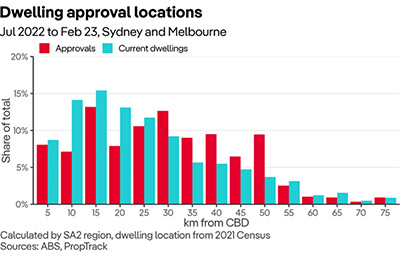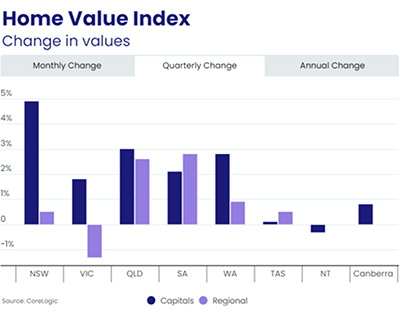Australia's multi-speed property market testing investors
It's a tale of two property markets emerging in Australia, as the outer suburbs show signs of struggling while the more affluent markets produce the capital growth.
While reports of a rise in homes being sold for less than what was paid for them roll in, home price indexes are showing a continuing rebound from this year’s lows.
Record prices are being paid at auction each week, at the same time as a leap in mortgage arrears.
How can we explain these contradictions? Welcome to the multi-speed real estate market.
Across Australia, the market is producing very different results depending on location.
On one side are buyers in a strong financial position thanks to the property rises of recent years. With low or no mortgages, these real estate shoppers have the means and the inclination to find what they’re looking for.
The only real problem to date: finding the right place. Listings of properties for sale have fallen by 25 per cent as owners, especially in these areas, hold on to their homes and investments.
On the other side are typically younger buyers seeing rising rates crimping the amount they can borrow.
They have to compete for homes still around 15 to 20 per cent more expensive than they were three years ago.
The better performing property markets
According to CoreLogic, values in 15 per cent of suburbs have hit a new peak this year.
So what areas are benefitting most? You can define what many of these areas are like with the phrase ‘20-minute city’.
It is a term that has been bandied about widely but often out of context. For investors, it refers to an area where residents can easily live and play within a 20-minute drive, train ride or walk from home and get to work in around half an hour.
To find them, start with long-established residential suburbs initially designed so locals had most facilities close by.
Many inner and middle ring suburbs meet this test, but few outer suburbs do.

That pattern is unlikely to change. As this chart below shows, while more people want to live closer to town, the homes being built are skewed to the outer suburbs.
It’s these high amenity, tightly held and development adverse inner and middle ring suburbs that are driving the current rebound.
You can find them right across inner Adelaide (which, by the way, had a stellar year recently), inner Brisbane and in Sydney from the eastern suburbs to better located areas in the west.
In Melbourne, it’s a loop swinging from Princes Hill and Brunswick and around through eastern suburbs like Surrey Hills and on to bayside areas such as Elsternwick.
Property prices are being pushed ever higher for luxurious prime and super prime homes.
Top Performing Melbourne Suburbs – House May 2023
| Suburb | Median price | Quarterly growth | Annual growth |
|---|---|---|---|
| Elsternwick | $2,175,000 | 12.0% | 20.8% |
| Caulfield | $1,850,000 | 5.8% | 8.8% |
| Mordialloc | $1,250,000 | 0.0% | 4.2% |
| Surrey Hills | $2,000,000 | 0.0% | 4.2% |
| Sandringham | $1,950,000 | -0.5% | 2.6% |
| Mount Waverley | $1,395,000 | 0.00% | 1.1% |
Source: CoreLogic
But the urban fringe is struggling
Out on the urban fringe, there are mostly low density, sprawling estates dominated by detached family homes.

Despite their more restricted access to shopping, recreational facilities and public transport, these areas enjoyed relatively good price movements in 2019 and when interest rates were rock bottom during the Covid period.
Once rates began rising, interest tapered off as buyers crunched the numbers of what a mortgage now costs.
Despite the broad market gains of the last few months, 27 per cent of suburbs remain at least 10 per cent below their peak, according to CoreLogic - and it’s outer suburban and some regional areas that dominate this group.
It’s important to keep the two-speed property in mind when looking at property indexes like this one. While capital city results look encouraging, the broad base of the index masks the different dynamics at play.
So, are the outer suburbs cooked?
Not necessarily – we have to take into account the negative and positive factors at play.
These more affordable areas are about to bear the brunt of the mortgage cliff, where 850,000 home owners come off low fixed rate mortgages and onto higher variable rates.
That will see borrowers forced to crimp their spending, in turn leading to more unemployment that will disproportionately fall on outer suburban residents who tend to have higher commitments and lower equity in their home.
That’s not a great set of factors. But countering these will be upward price pressure as more migrants come to Australia competing for less homes on the market to rent or buy.
Perth is one city where the outer suburbs are currently outperforming the more affluent inner city and western suburbs.
There’s also the counterintuitive effect of rising rates cutting the amount buyers can borrow, channelling more people towards affordable homes.
A similar tussle between the positive and negative may come into play in this year’s best performing suburbs, as more and more borrowers find themselves priced out due to higher rates.
You will also see this two-speed market play out in regional centres. While provincial centres were the darling of the market in 2022, especially in NSW, that party is over.
What we’re likely to see now is a continuing decline in smaller towns while major centres stabilise, as is happening in Albury, Geelong, Ballarat and Bendigo.
How do investors factor in multi-speed markets?
The first thing to do is to take this multi-speed market seriously, as it could be a good indicator of where we’ll be in the next two years.
The second thing to do is get some professional advice before going ahead. While there are some great investment opportunities available now, this is not the time to be buying “based on my gut feeling”.
I’ve often told clients that only 8 per cent of the properties meet what we call investment grade – being less affected by downturns and better positioned for the upward cycle.
Some have scoffed at that idea during the boom times but not many of them will be now.
Many of the properties in this year’s high return suburbs don’t meet the investment grade test and are likely to underperform in the years ahead.
That’s why it pays for investors to understand all the factors at play before buying into Australia’s multi-speed property market.





















